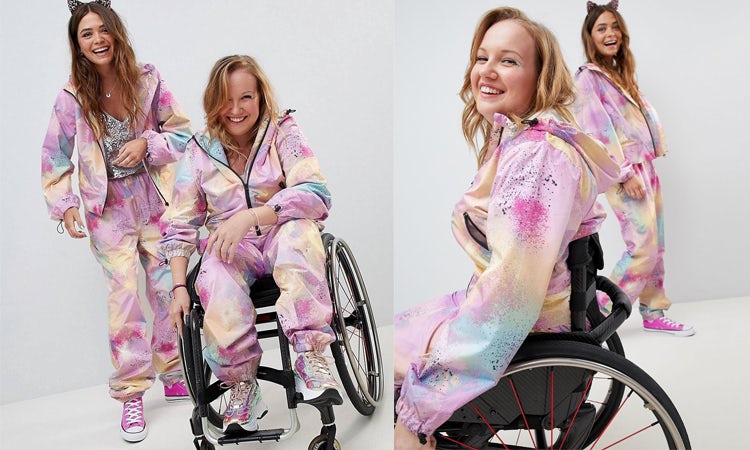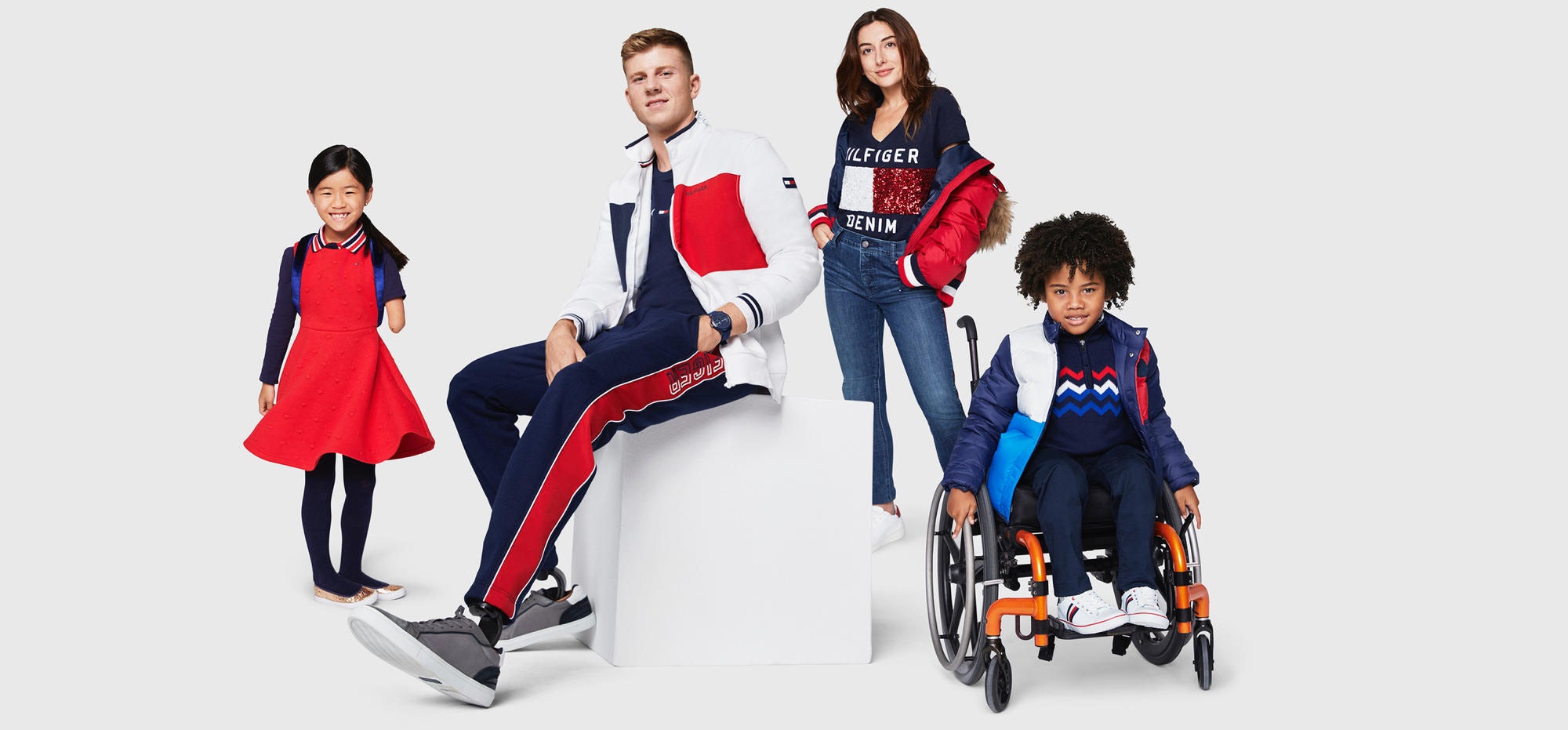What brands are doing to be more inclusive for people with disabilities
From Asos’s wheelchair-friendly jumpsuit to Starbucks opening its first sign language store, brands are making moves to cater for people beyond the mainstream and unlock the potential of the ‘Purple Pound’.
 It is thought that the collective spending power of disabled people – known as the Purple Pound – is worth £249bn to the UK economy. And yet many brands and retailers still don’t seem to know how to accommodate the needs of disabled consumers.
It is thought that the collective spending power of disabled people – known as the Purple Pound – is worth £249bn to the UK economy. And yet many brands and retailers still don’t seem to know how to accommodate the needs of disabled consumers.
Whether down to poorly designed stores, lack of staff training or simply not offering products and clothes that are disabled-friendly or, in many cases, clothes that are so far from mainstream fashion trends, retailers are excluding one in five people in the UK who has a disability or impairment – and in doing so missing out on a potentially substantial profit.
But there are signs that these deep-rooted prejudices around disability are, finally, beginning to loosen.
The fashion industry might be quick when it comes to trends, but it has been slow to represent people of different sizes, ethnicities and abilities.
Parents passionately told us that disabilities don’t define their children, so the adaptations shouldn’t define their clothes.
Rebecca Garner, M&S
2018, however, saw the likes of Marks & Spencer (M&S), Tommy Hilfiger, River Island and Asos all move in a more inclusive direction – from changes in advertising campaigns to innovative clothing lines.
M&S and Tommy Hilfiger both launched adaptive clothing ranges designed for adults and children with physical and mental disabilities, showing that retailers at both ends of the fashion spectrum are beginning to realise there is a wide audience waiting to be catered for.
Key for both brands was involving the disabled community at the beginning, from the initial design stage right the way through to marketing the ranges.
Tommy Hilfiger’s range includes clothes with one-handed zips, extended openings, adjustable waists and magnetic closures – all of which maintain the style of the brand.

Similarly, M&S’s Easy Dressing kidswear range was conceived, designed and developed with its customers over a two-year period, starting with a survey of 300 parents, and designed to be as close to the main kidswear range as possible.
“Parents passionately told us that disabilities don’t define their children, so the adaptations shouldn’t define their clothes, it’s why all the products are inclusively designed and modelled closely on our main collection,” explains Rebecca Garner, M&S’s kidswear designer.
“Offering great value was a key consideration throughout the development, so our Easy Dressing products are priced in line with the rest of our kidswear range. One thing we’re very proud of on this range is the imagery we’ve used online, it was absolutely vital for us that the range was inclusively modelled.”
When actress and disability campaigner Samantha Renke, who starred in Maltesers’ award-winning ‘Look on the Light Side’ campaign, was approached by bag brand Mia Tiu on Instagram around six months ago, she began her mission to change the way retailers think about designing and selling products to people with disabilities.
From the outside, Mia Tui’s Samantha bag, which launched towards the end of 2018, looks like any other bag available on the high street: it is colourful, stylish and practical. But its practicality extends much further than most.
Brands need to sit down with [disabled] people and say right, tell me what you need and want.
Samantha Renke, actress and disability campaigner
Initially designed for busy mums to clip on to the back of buggies, Mia Tui soon realised it could do the same job for people in wheelchairs. However, Renke says it felt “a bit like an afterthought” to broaden their market, and so she offered “constructive feedback”, as well as reaching out to people with a range of disabilities on social media, to tweak the design to make it more inclusive.
This included changing the inside of the bag colour to bright blue for visually impaired people, and making sure the clasp wasn’t magnetic so it could be used by people with pacemakers.
Where it differs from adaptive ranges like M&S and Tommy Hilfiger is that while it has been designed with disabled people in mind, it is not just for disabled people.
“The little tweaks I’ve made would benefit [disabled] people greatly but if you didn’t point them out to someone you would just think it’s a bag,” Renke says.
“This is what we want to show to retailers because I genuinely believe they get quite scared when they think of disability, they think it’s going to be a niche market or they’re going to have to really change their products. But actually you don’t have to.”
Renke says she would rather brands create products that can be used by both disabled and able-bodied people, rather than separate ranges,
“Brands need to get away from this segregation,” Renke says. “If you were to take the word disability and change it for any other minority group they would be outraged. [Disabled people] aren’t so different and that’s what people need to get their head around. Brands need to sit down with people and say right, tell me what you need and want.”
READ MORE: How Mars is expanding Maltesers’ diversity agenda to all its brands
Asos is one brand that has managed to be inclusive without being exclusionary with the launch of its wheelchair-friendly jumpsuit last year.
The online retailer worked with GB Paralympic hopeful Chloe Ball-Hopkins to create a “fashionable yet practical” jumpsuit that could be worn by everyone, whether they are in a wheelchair or not.
Like Renke, Ball-Hopkins says “it’s about making fashion accessible”.
This is something that River Island has been pushing over the last 12 months too with its pro-diversity campaign, ‘Labels are for clothes’, which features models of different genders, sexualities, ethnicities, religions, sizes and disabilities.
Marking its 30th anniversary, the retailer kick-started the campaign last February featuring six children with conditions including Down’s syndrome, cerebral palsy and eyesight issues as the new faces of the campaign.
In September, it launched the second part of the campaign, this time featuring adults including wheelchair basketball star Jordan and plus-size model Lulu.
Then, in October, Superdry unveiled a disabled mannequin shop window on London’s Regent Street as part of the brand’s partnership with Team UK for Prince Harry’s The Invictus Games.
The mannequins were dressed in specially designed kits for the team – something Superdry is planning to do on a global level this year.
While there are no immediate plans to launch a consumer range, Superdry says it will continue to review how best to serve its customers and reflect diversity within campaigns going forward.
“The kit we produced for Team UK was designed based on the individual needs of each competitor and we’ve learnt a lot about creating clothes that cater for people with physical disabilities,” explains Ross Burchell, Superdry’s global marketing manager.
“While we have no immediate plans to launch a range in the near future, we are constantly reviewing how best to serve our consumers through the creation of great product.”
Beyond fashion

There are interesting developments going on outside of the fashion world too. In October, Starbucks opened its first sign language store in the US state of Washington where all employees are fluent in American sign language.
Deaf employees wear an apron created by a deaf supplier with ‘Starbucks’ spelled out in American sign language, while those who don’t have hearing impairments wear a pin that says ‘I sign’. Customers who are new to sign language can also use digital notepads to communicate with staff.
That the store is open to people without hearing impairments too makes it an example of diversity and inclusion done right, without it making people feel like they are being singled out for their disability – something that brands need to pay careful attention to.
Meanwhile, Procter & Gamble’s Herbal Essences became the first mass hair care brand in North America to introduce an inclusive bottle design for people with low to no vision.
Designed by the business’s special consultant for inclusive design, Sumaira Latif, who has been at P&G for over 18 years and is blind herself, the newly enhanced bottle features tactile indentations that will help differentiate the brand’s shampoos from its conditioners given they share the same bottle shape.
READ MORE: P&G on why diversity has to be about more than ‘showing up with a rainbow bottle’
Latif says it was important to invent a universally recognisable tactile feature which would work for people who haven’t had the opportunity to learn braille.
However, it is not a case of simply bringing a product to market. As Latif explains: “While the solution might sound relatively simple, we process hundreds of bottles a minute, so changing a manufacturing process is complicated when you’re dealing with those kinds of quantities”.
The challenges, of course, go beyond production and begin with how society views disability as a whole.
Renke explains: “If [disabled] people aren’t being employed, then how are they going to be part of a team where they can say they’ve got an idea? It’s a vicious circle and it goes back to that. We need to be going to university, getting employment, so we can be creative and contribute.
“It’s also to do with this stereotype that disabled people don’t have income to spend, that we’re all on benefits or we don’t go out.”
As the Purple Pound proves, this stereotype is far from true. Brands that realise this will not only be richer for it, they will be making millions of people’s lives easier and helping to make society a better, less prejudiced place to live in.







Employers also need to be more inclusive in who they hire, to reap the benefits of extra skills that people with both seen and unseen disabilities have. Acceptance and tolerance are key.